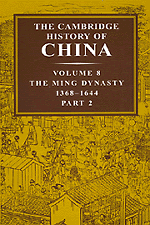Book contents
- Frontmatter
- Introduction
- 1 Ming government
- 2 The Ming fiscal administration
- 3 Ming law
- 4 The Ming and Inner Asia
- 5 Sino-Korean tributary relations under the Ming
- 6 Ming foreign relations: Southeast Asia
- 7 Relations with maritime Europeans, 1514–1662
- 8 Ming China and the emerging world economy, c. 1470–1650
- 9 The socio-economic development of rural China during the Ming
- 10 Communications and commerce
- 11 Confucian learning in late Ming thought
- 12 Learning from Heaven: the introduction of Christianity and other Western ideas into late Ming China
- 13 Official religion in the Ming
- 14 Ming Buddhism
- 15 Taoism in Ming culture
- Bibliographic notes
- Bibliography
- Glossary-Index
- References
1 - Ming government
Published online by Cambridge University Press: 28 March 2008
- Frontmatter
- Introduction
- 1 Ming government
- 2 The Ming fiscal administration
- 3 Ming law
- 4 The Ming and Inner Asia
- 5 Sino-Korean tributary relations under the Ming
- 6 Ming foreign relations: Southeast Asia
- 7 Relations with maritime Europeans, 1514–1662
- 8 Ming China and the emerging world economy, c. 1470–1650
- 9 The socio-economic development of rural China during the Ming
- 10 Communications and commerce
- 11 Confucian learning in late Ming thought
- 12 Learning from Heaven: the introduction of Christianity and other Western ideas into late Ming China
- 13 Official religion in the Ming
- 14 Ming Buddhism
- 15 Taoism in Ming culture
- Bibliographic notes
- Bibliography
- Glossary-Index
- References
Summary
The Ming dynasty is generally known as a period of stable, effective government during which some important new institutions developed. Although in the end the dynasty collapsed under the pressures of domestic rebellions and foreign invasions, it had long seemed the most secure and unchallengeable ruling house the Chinese had known, and its institutions were largely perpetuated with admiration by the succeeding Ch'ing dynasty.
The system of governance that matured in Ming times was the culmination of trends that became evident after the mid-T'ang period, developed markedly in Sung times, and were further stimulated by the Mongol occupation of China during the Yüan dynasty. The emperor was a supreme autocrat. Administration of the empire on his behalf was entrusted to Confucian-indoctrinated scholars who were selected for service on the basis of their scholastic merit as demonstrated in competitive recruitment examinations, who made career progress very largely on the basis of service judged by their peers to be meritorious, and who constituted a civil service that was significantly self-regulating.
The civil service dominated government to an unprecedented degree. It was not seriously challenged by hereditary nobles or military officers, although eunuch agents or manipulators of emperors often disrupted civil service dominance. Society at large was thoroughly integrated into the state to such an extent that, during the final decades of the Ming dynasty, rulers were securely in control of everything they wished to control, and no other group in society rivaled the status of the civil officialdom as the natural leaders of society.
- Type
- Chapter
- Information
- The Cambridge History of China , pp. 9 - 105Publisher: Cambridge University PressPrint publication year: 1998
References
- 10
- Cited by

